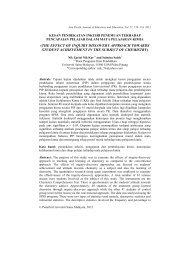Author template for journal articles - Asia Pacific Journal of ...
Author template for journal articles - Asia Pacific Journal of ...
Author template for journal articles - Asia Pacific Journal of ...
Create successful ePaper yourself
Turn your PDF publications into a flip-book with our unique Google optimized e-Paper software.
William Koh Siaw Yen and Ong Saw Lan<br />
structural equation modelling (SEM). Kesemua konstruk menunjukkan unidimensionaliti<br />
apabila nilai PCAR berada dalam lingkungan 47.10% hingga 73.60%. Nilai eigen kurang<br />
daripada 3.0 turut memberikan indikasi bahawa konstruk adalah unidimensi. Secara<br />
keseluruhannya, SPA mempamerkan konsistensi yang tinggi walaupun menggunakan dua<br />
kaedah yang berbeza di antara Rasch dan SEM. Persamaan yang mencapai 80% di antara<br />
item terpilih memberikan implikasi bahawa pemilihan item adalah agak stabil walaupun<br />
menggunakan dua kaedah berbeza. Akhir sekali, multidimensionaliti instrumen turut<br />
dikesan.<br />
Katakunci: Model Pengukuran Rasch, Permodelan Persamaan Struktural, pemilihan<br />
item.<br />
INTRODUCTION<br />
Student-Parent Actions Model (SPA) was developed using classical test theory<br />
(CTT) and structural equation modelling (SEM) to investigate the contributing<br />
dimensions <strong>of</strong> parents' observable actions towards their children's academic<br />
achievement and discipline in Malaysia (Koh & Ong, 2010). SPA is a self-report<br />
questionnaire that captures parental action constructs related to their adolescent<br />
children's academic achievement. Rasch measurement model (Rasch) and SEM<br />
are two approaches increasingly employed in all fields <strong>of</strong> social science research<br />
(Bartholomew & Knott, 1999; Bollen, 2002; Lamoureux, Pallant, Pesudovs,<br />
Hassel, & Keeffe, 2006; MacCallum & Austin, 2000; Merrell & Tymms, 2005;<br />
Pallant & Tennant, 2007). Some authors have suggested that using the Rasch<br />
measurement model to assess scaling properties <strong>of</strong> questionnaires is preferable to<br />
using CTT and confirmatory factor analysis (Nijsten, Unaeze, & Stern, 2006;<br />
Prieto, Alonso, & Lamarca, 2003; Wright, 1999). Others have claimed that these<br />
two approaches exhibit similar statistical frameworks and support hypothesisdriven<br />
data analysis in the social sciences (Bartholomew & Knott, 1999;<br />
Glockner-Rist & Hoijtink, 2003) and have there<strong>for</strong>e suggested integrating both<br />
approaches. However, Waugh and Chapman (2005) commented that factor<br />
analysis may provide misleading evidence that a scale is working well when it is<br />
not. There<strong>for</strong>e, this study is interested in reassessing the item selection<br />
consistency (Allen & Oshagan, 1995; Bollen, 1989) <strong>of</strong> SPA when Rasch model<br />
approach is utilised.<br />
Hence, the objectives <strong>of</strong> this study are (1) to determine the consistency <strong>of</strong> item<br />
selection in SPA and (2) to use Rasch analysis to validate the unidimensionality<br />
<strong>of</strong> the model's individual constructs.<br />
The original SPA contains 34 items and uses a 5-point Likert-type scale. Items<br />
are grouped into eight dimensions, which are hypothesised 'a priori' using the<br />
SEM technique. Example items include the following: (1) "My parents discuss<br />
120







